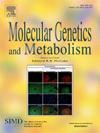定量肌肉超声作为婴儿起病庞贝病疾病进展的窗口
IF 3.5
2区 生物学
Q2 ENDOCRINOLOGY & METABOLISM
引用次数: 0
摘要
背景:早发性庞贝病(IOPD)是由酸性α葡萄糖苷酶缺乏引起的,导致糖原在肌肉和其他组织中积累。如果不进行治疗,受感染的婴儿通常会在两年内死亡。酶替代疗法(ERT)显著提高了生存率和功能预后,特别是早期开始、高剂量、免疫调节和更新的治疗选择。然而,仍然需要有效的非侵入性工具来监测疾病进展和治疗反应。定量肌肉超声(QMUS)可以作为一种有用的替代方法。目的评价QMUS监测IOPD肌肉受累的有效性和可行性。方法本研究评估了8例接受长期ERT治疗的IOPD患者QMUS的回声强度(EI)测量结果。每年在7个肌肉群中记录EI。EI >;50为异常,计算综合EI Sum Score。使用单变量回归将这些值与大肌肉运动功能测量(GMFM)评分进行比较。结果患者开始ERT治疗的中位年龄为7周。进行QMUS评估,首次评估时年龄范围为7个月至21岁(中位年龄9.5岁)。所有患者至少有一个肌群出现EI异常。上肢EI(平均47.3)明显低于下肢肌群(平均64.1,p = 0.002)。较高的EI分数与更严重的肌病和轮椅使用相关,而较低的分数反映了更好的运动结果。结论sqmus是一种很有前途的无创工具,可用于监测接受ERT治疗的IOPD患者的肌肉健康状况。它可能有助于评估疾病进展和治疗效果。本文章由计算机程序翻译,如有差异,请以英文原文为准。
Quantitative muscle ultrasound as a window into disease progression in infantile-onset Pompe disease
Background
Infantile-onset Pompe disease (IOPD) is caused by a deficiency of the enzyme acid alfa glucosidase, resulting in glycogen accumulation in muscles and other tissues. Without treatment, affected infants typically die within two years. Enzyme replacement therapy (ERT) has significantly improved survival and functional outcomes, especially with early initiation, higher dosing, immune modulation, and newer therapeutic options. However, effective noninvasive tools to monitor disease progression and treatment response are still needed. Quantitative muscle ultrasound (QMUS) may serve as a useful alternative.
Objective
To evaluate the effectiveness and feasibility of QMUS for monitoring muscle involvement in IOPD.
Methods
This study assessed echo intensity (EI) measurements from QMUS in eight patients with IOPD receiving long-term ERT. EI was recorded annually in seven muscle groups. EI >50 units was considered abnormal, and a composite EI Sum Score was calculated. These values were compared with Gross Motor Function Measure (GMFM) scores using univariable regression.
Results
Patients began ERT at a median age of 7 weeks. QMUS assessments were performed, with ages ranging from 7 months to 21 years (median age of 9.5 years) at first evaluation. All patients had at least one muscle group with abnormal EI. Upper extremity EI was significantly lower (mean 47.3) than lower extremity muscle groups (mean 64.1, p = 0.002). Higher EI scores correlated with more severe myopathy and wheelchair use, while lower scores reflected better motor outcomes.
Conclusions
QMUS is a promising noninvasive tool for monitoring muscle health in patients with IOPD receiving ERT. It may aid in assessing disease progression and treatment efficacy.
求助全文
通过发布文献求助,成功后即可免费获取论文全文。
去求助
来源期刊

Molecular genetics and metabolism
生物-生化与分子生物学
CiteScore
5.90
自引率
7.90%
发文量
621
审稿时长
34 days
期刊介绍:
Molecular Genetics and Metabolism contributes to the understanding of the metabolic and molecular basis of disease. This peer reviewed journal publishes articles describing investigations that use the tools of biochemical genetics and molecular genetics for studies of normal and disease states in humans and animal models.
 求助内容:
求助内容: 应助结果提醒方式:
应助结果提醒方式:


